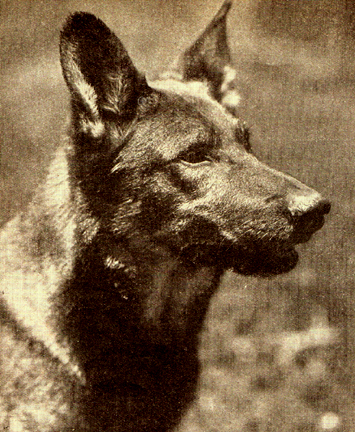 Not all movie stars are bipeds. Some of the most beloved and most well known have been man's best friend. What's the good thing about dog stars? You don't have to pay them millions for a single movie, they don't have ridiculous demands, they don't argue about details on their contract and you don't have to worry about their ego getting in the way of their work. What's the bad thing? Slobber, barking, and you they may run off the set... to chase a cat.
Not all movie stars are bipeds. Some of the most beloved and most well known have been man's best friend. What's the good thing about dog stars? You don't have to pay them millions for a single movie, they don't have ridiculous demands, they don't argue about details on their contract and you don't have to worry about their ego getting in the way of their work. What's the bad thing? Slobber, barking, and you they may run off the set... to chase a cat.Perhaps the first movie star on all fours was Rin Tin Tin. The German Shepherd was found shell shocked by serviceman Lee Duncan in a bombed dog kennel in Lorraine, France. He was named for a puppet called Rintintin that French children gave to the American soldiers for good luck. The puppy returned with Lee to his home in Los Angeles after the war.
Throughout the 1920s Rinty, as he was called by his owner, toured the US performing in dog shows. Eventually he appeared in many silent films and four sound films. In addition to movies, he could be heard on the radio. Rin Tin Tin was well known for his ability to jump at great heights.
After his death Rin Tin Tin was given a star on the Hollywood Walk of Fame. After his death, Rin Tin Tin's career was continued by his relatives. The current Rin Tin Tin is tenth from his original ancestor. The line of dogs are also trained as service dogs for special needs children.
 Lassie's first appearance was not on the big screen but in a short story published in the Saturday Evening Post in 1938 called "Lassie Come-Home." The story eventually became a novel, and the novel made it to the big screen in 1943. The film was such a success that three more movies were made during the 40s starring the Collie.
Lassie's first appearance was not on the big screen but in a short story published in the Saturday Evening Post in 1938 called "Lassie Come-Home." The story eventually became a novel, and the novel made it to the big screen in 1943. The film was such a success that three more movies were made during the 40s starring the Collie.From 1954-1973 the television show "Lassie" was broadcast in the United States. Instead of taking place in England like the films, the small screen Lassie lived in weather beaten American Midwest. For the first 10 seasons Lassie was teamed up with a boy on a farm, then she worked with forestry workers. For the last two seasons she found herself with a group of juvenile inmates at a home for troubled children.
Like Rin Tin Tin, all the Lassies are bred from one dog. The dog of the 1945 called Pal, is at the heart of the Lassie family. The interesting thing about Lassie is that although the dog in the series was a female, all the actors were male. The reason is that male collies have thicker coats which look better on screen and males are bigger which means that directors did not have to worry about child actors growing too much during filming.
 He may not be real, but he's one of the best loved dogs in the business. Yes, I'm talking about your favorite hungry hound Scooby Doo. The talking Great Dane has been on screen since 1969, voiced by Don Messick until 1996.
He may not be real, but he's one of the best loved dogs in the business. Yes, I'm talking about your favorite hungry hound Scooby Doo. The talking Great Dane has been on screen since 1969, voiced by Don Messick until 1996.Scoobert "Scooby" Doo was born on the Knittingham Puppy Farm, and has some problems with pronunciation, sometimes pronouncing words with an "R." This stems from the fact that he is a dog. Scooby has a vast array of relatives which include nephew Scrappy-Doo, cousin Scooby-Dum, and brother Yabba-Doo.
On a side note, Don Messick voiced Astro, the Jetsons' beloved family dog, who also pronounce a lot of things with Rs.
 Perhaps the largest of the movie dogs is Beethoven. The St. Bernard has starred in six films. He got his name from barking in approval when someone played Beethoven's Fifth Symphony. Beethoven had four puppies with the Missy, as St. Bernard with a pink bow.
Perhaps the largest of the movie dogs is Beethoven. The St. Bernard has starred in six films. He got his name from barking in approval when someone played Beethoven's Fifth Symphony. Beethoven had four puppies with the Missy, as St. Bernard with a pink bow.Beethoven has an ear for classical music and loves to eat shoes and drool. St. Bernards like Beethoven originate from Switzerland and were originally bred to rescue trapped mountain climbers on the Alps. A standard St. Bernard stands from 28-36 inches high and can weigh between 160-240 lbs.
St. Bernards come from a monastery along the Great St. Bernard Pass. The monks used the dogs for hunting rescue and watchdogs. The dogs are typically pictured wearing a small cask of Brandy around their necks, which is supposed to warm trapped mountaineers. In reality Brandy would exacerbate the suffering a freezing hiker. Although the monks do not know where the Brandy myth came from, the dogs do wear casks around their necks now for the sake of tourists.





